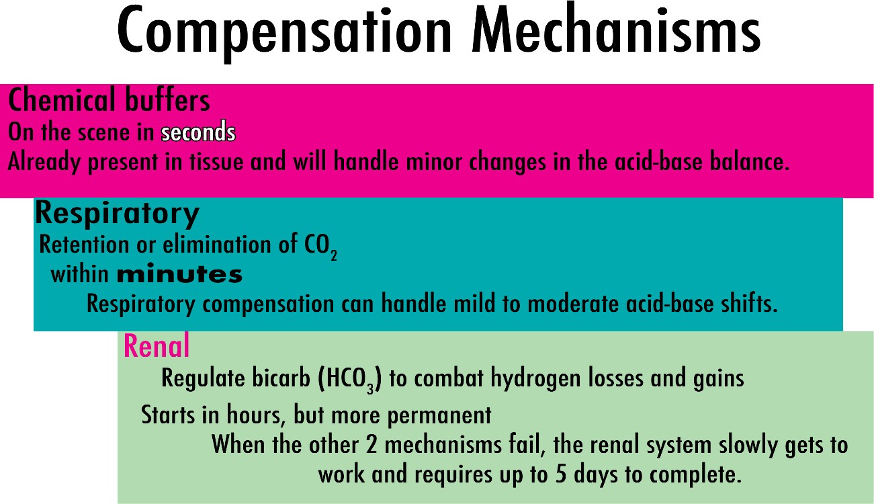The parents of a child with acid-base imbalance ask the nurse about mechanisms that regulate acid-base balance. Which statement by the nurse accurately explains the mechanisms regulating acid-base balance in children?
The cardiovascular and integumentary systems
The respiratory, renal, and chemical-buffering systems
The kidneys balance acid: the lungs balance base.
The skin, kidney, and endocrine systems
The Correct Answer is B
The regulation of acid-base balance in the body involves multiple systems working together. The respiratory system, renal system, and chemical-buffering systems play key roles in maintaining the balance of acids and bases in the body.
The respiratory system helps regulate acid-base balance through the control of carbon dioxide (CO2) levels in the blood. By adjusting the rate and depth of breathing, the respiratory system can increase or decrease the elimination of CO2, which affects the pH of the blood.
The renal system (kidneys) plays a crucial role in regulating acid-base balance by controlling the excretion and reabsorption of hydrogen ions (H+) and bicarbonate ions (HCO3-) in the urine. The kidneys can excrete excess acids or bases to help maintain the body's pH within a normal range.
The chemical-buffering systems involve various chemical compounds in the body that can absorb or release hydrogen ions to help maintain pH balance. Examples of chemical buffers include bicarbonate ions (HCO3-), phosphate ions (HPO4-), and proteins.
the cardiovascular and integumentary systemin (option A) is incorrect because they, are not primarily responsible for regulating acid-base balance in the body.

Nursing Test Bank
Naxlex Comprehensive Predictor Exams
Related Questions
Correct Answer is B
Explanation
The statement that best describes why infants are at greater risk for dehydration than older children is option B. Infants have an increased extracellular fluid volume compared to older children. This means that a larger proportion of their total body fluid is located outside the cells, in the extracellular compartment. This higher extracellular fluid volume makes infants more susceptible to fluid losses and dehydration if they experience inadequate fluid intake or increased fluid losses.
infants have an increased ability to concentrate urine in (option A), is incorrect. Infants have limited renal function and may have difficulty concentrating urine compared to older children and adults. This can contribute to a higher risk of dehydration in infants.
infants have a greater volume of intracellular fluid in (option C), is incorrect. The volume of intracellular fluid is not the primary factor contributing to the increased risk of dehydration in infants.
infants have a smaller body surface area in (option D) is incorrect because it, is not directly related to the increased risk of dehydration. Body surface area influences heat exchange and fluid loss through sweating but is not the main factor contributing to the higher risk of dehydration in infants.
Correct Answer is A
Explanation
A. The harness maintains the hips in flexion, abduction, and external rotation
The factor that the nurse should include when teaching a parent about the care of a newborn
in a Pavlik harness for hip dysplasia is that the harness maintains the hips in flexion,
abduction, and external rotation. The Pavlik harness is a commonly used device for the
treatment of developmental dysplasia of the hip (DDH) in infants. It is designed to hold the
hips in a position that promotes proper alignment and development.
The harness maintains the hips in flexion, abduction and external rotation in (Option B) is
incorrect. The Pavlik harness should not be removed with every diaper change. The harness
needs to be worn consistently as directed by the healthcare provider to ensure the
effectiveness of the treatment.
The harness is the only first step of treatment in (Option C) is incorrect. While the Pavlik
harness is an important step in the treatment of hip dysplasia, it is not the only step.
Additional treatments, such as bracing or surgical interventions, may be required depending
on the severity of the condition.
The harness in worn for 2 weeks in (Option D) is incorrect. The duration for which the Pavlik
harness is worn can vary depending on the individual case and the healthcare provider's
instructions. It is typically worn for several weeks to months, and the specific duration will be
determined by the healthcare provider based on the child's progress and response to
treatment.

Whether you are a student looking to ace your exams or a practicing nurse seeking to enhance your expertise , our nursing education contents will empower you with the confidence and competence to make a difference in the lives of patients and become a respected leader in the healthcare field.
Visit Naxlex, invest in your future and unlock endless possibilities with our unparalleled nursing education contents today
Report Wrong Answer on the Current Question
Do you disagree with the answer? If yes, what is your expected answer? Explain.
Kindly be descriptive with the issue you are facing.
